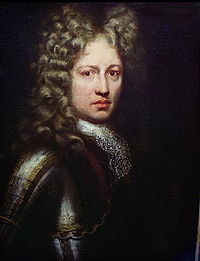Siege of Limerick (1690)
| Siege of Limerick 1690 | |||||||
|---|---|---|---|---|---|---|---|
| Part of the Williamite War in Ireland | |||||||
 Patrick Sarsfield, 1st Earl of Lucan, Irish Jacobite cavalry commander |
|||||||
|
|||||||
| Belligerents | |||||||
| Jacobite forces | Williamite forces | ||||||
| Commanders and leaders | |||||||
|
Marquis de Boisseleau Earl of Tyrconnell Patrick Sarsfield |
William III of England | ||||||
| Strength | |||||||
| 14,500 Jacobite infantry in Limerick, 2,500 cavalry in Clare | 25,000 men | ||||||
| Casualties and losses | |||||||
| ~400 killed in action | ~3,000 killed in assault, 2,000 died of disease | ||||||
Limerick, a city in western Ireland, was besieged twice in the Williamite War in Ireland, 1689-1691. On the first of these occasions, in August to September 1691, its Jacobite defenders retreated to the city after their defeat at the Battle of the Boyne. The Williamites, under William III, tried to take Limerick by storm, but were driven off and had to retire into their winter quarters.
Following the successful defence of Derry and the Siege of Carrickfergus, the Jacobites had lost control over the north of Ireland by late 1689. Their defeat at the Battle of the Boyne on July 1, 1690 saw their forces make a disorderly retreat from the eastern part of the country, abandoning the capital Dublin in the process. James II himself had fled Ireland for France, judging his military prospects there to be hopeless. The Irish Jacobites still in the field found themselves in the same position as the Catholic Confederates of a generation before – holding an enclave behind the river Shannon, based on the cities of Limerick and Galway. The main Jacobite army had retreated to Limerick after their defeat at the Boyne.
Some of their senior commanders, in particular Richard Talbot, 1st Earl of Tyrconnell, wanted to surrender to the Williamites while they could still get good terms, but they were overruled by Irish officers such as Patrick Sarsfield, who wanted to fight on. The principal reason why many Jacobite officers were reluctant to surrender was the harsh surrender terms published by William in Dublin after his victory at the Boyne. These terms offered a pardon only to the Jacobite rank and file and not to the officers or to the landowning class. The Jacobite’s French commander, Lauzun, also wanted to surrender, expressing his dismay at the state of Limerick’s fortifications, saying that they could be "knocked down by roasted apples".
...
Wikipedia
